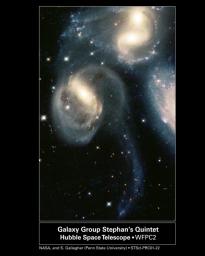A famous group of five compact galaxies featured in the holiday film classic "It's a Wonderful Life" appears in a new image from NASA's Hubble Space Telescope.
In the movie, angelic figures take on the form of the galactic group called Stephan's Quintet. But the new pictures show the group has actually been doing some devilish things. At least two of its galaxies have been involved in high-speed, hit-and-run accidents, ripping stars and gas from neighboring galaxies and tossing them into space.
The image, taken by Hubble's Wide Field and Planetary Camera 2, is online at http://hubblesite.org/newscenter/archive/releases/2001/22. The camera was designed and built by NASA's Jet Propulsion Laboratory, Pasadena, Calif.
The close-up view of Stephan's Quintet reveals a string of bright star clusters sparkling like a diamond necklace. The clusters, each harboring up to millions of stars, were born from the violent interactions between some members of the group. The rude encounters also have distorted the galaxies' shapes, creating elongated spiral arms and long, gaseous streamers.
The photo showcases three regions of star birth: the long, sweeping tail and spiral arms of the galaxy NGC 7319 (near center); the gaseous debris of two galaxies, NGC 7318B and NGC 7318A (top right); and the area north of those galaxies, dubbed the northern starburst region (top left).
The clusters' bluish color indicates that they're relatively young -- between about 2 million to more than 1 billion years old. The brilliant star clusters in NGC 7318B's spiral arm and the northern starburst region are between 2 million and more than 100 million years old. NGC 7318B instigated the starburst by barreling through the region. The bully galaxy is just below NGC 7318A at top right.
Although NGC 7318B appears dangerously close to NGC 7318A, it's traveling too fast to merge with its neighbor. The partial galaxy on the far right is NGC 7320, a foreground galaxy not physically bound to the other galaxies in the picture.
About 20 to 50 of the clusters in the northern starburst region reside far from the coziness of galaxies. The clusters were born about 150,000 light-years from the nearest galaxy.
Another galaxy, NGC 7320C, which is no longer part of the group and is not seen in the photo, plowed through the quintet several hundred million years ago. It pulled out the long tail of gaseous debris from NGC 7319. The clusters in NGC 7319's streaming tail are 10 million to 500 million years old and may have formed at the time of the violent collision. The faint bluish object at the tip of the tail is a young dwarf galaxy, which formed in the gaseous debris.
Stephan's Quintet is in the constellation Pegasus, 270 million light-years from Earth.
The pictures in this mosaic were taken by the Wide Field Planetary Camera 2 on Dec. 30, 1998 and June 17, 1999. Additional information about the Hubble Space Telescope is online at http://www.stsci.edu/hst/. More information about the Wide Field and Planetary Camera 2 is at http://www.stsci.edu/hst/wfpc2.
The Space Telescope Science Institute, Baltimore, Md., manages space operations for Hubble for NASA's Office of Space Science, Washington, D.C. The institute is operated by the Association of Universities for Research in Astronomy, Inc., for NASA, under contract with the Goddard Space Flight Center, Greenbelt, Md. The Hubble Space Telescope is a project of international cooperation between NASA and the European Space Agency. JPL is a division of the California Institute of Technology in Pasadena.

 Planetary Data System
Planetary Data System












